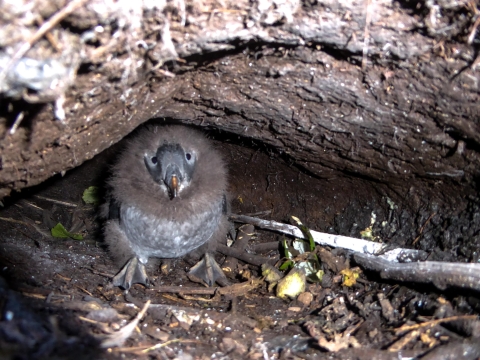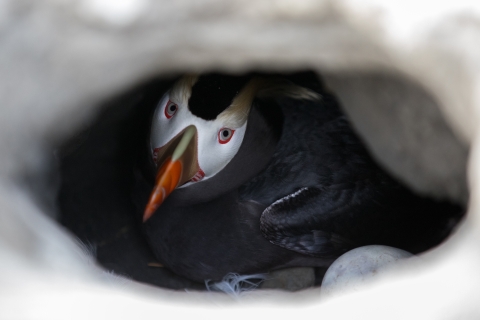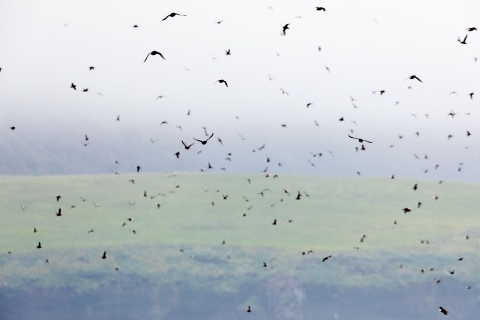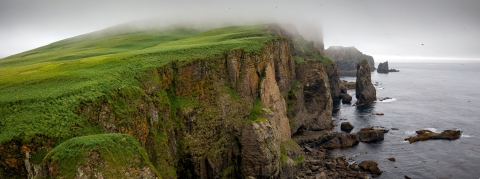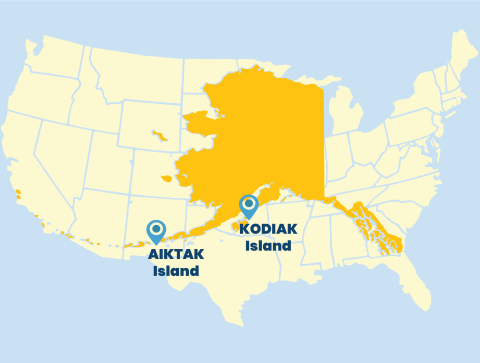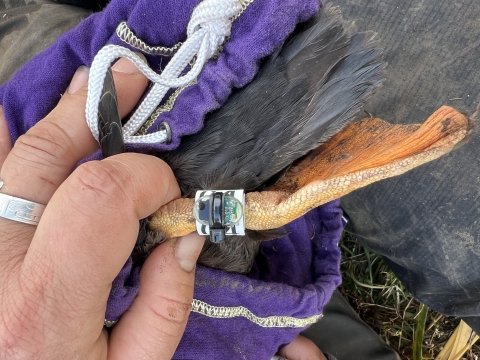At the end of August along the Alaskan coast, fuzzy gray pufflings fledge from their earth burrows into sleek, dark seabirds. They follow their parents to the sea to make their way in the marine world, the start of a migration away from land for the next several months.
Auk-wardly adorable: a puffin chick in the transition from puffling to fledgling, at a burrow on Alaska Maritime National Wildlife Refuge.
Hi! I'm a newly fledged tufted puffin leaving my burrow and exploring the ocean near Kodiak Island for the first time.
About 96% of the tufted puffins in North America come to shore in Alaska in the summer to nest and raise chicks. They breed at several national wildlife refuges in the state, including Alaska Maritime, Kodiak, Izembek, Alaska Peninsula/Becharof, and Togiak refuges.
A tufted puffin in a burrow on Bogoslof Island, photographed during a seabird monitoring study.
Puffins swirl off the coast of Aiktak Island in Alaska Maritime National Wildlife Refuge. On land, a group of puffins is usually called a colony. In the air, you might call them a "whirl" of puffins. At sea, they might be a "raft." Other collective names include: a "circus," a "burrow," a "puffinry," or an "improbability" of puffins.
But where do they go once they leave land?
Tufted puffins in Alaska winter offshore in the North Pacific Ocean. Their historical wintering range includes an almost 4.5 million square mile area of water. Looking for a puffin in the winter can be like trying to find a breadcrumb on a beach…
A molting tufted puffin on the ocean. As fall approaches, tufted puffins go through a costume change, losing their white eye mask and yellow plumes. Their colorful orange beak and feet fade to a muted version of summer colors.
We know very little about tufted puffins during the months spent at sea away from breeding colonies. Do they use the same large marine ecosystem areas near their colonies, or do they go to a different system and mingle with other tufted puffins from different colonies? Do they depend on ocean currents? Do puffins from one breeding colony disperse across wide areas, or do they tend to migrate to the same locations as a group?
Any guesses where this puffin might go once it leaves the Kodiak coast for the winter?
In 2021 and 2022, Alaska Maritime and Kodiak National Wildlife Refuges began new research studies to find a few of these puzzle pieces. We hope to learn more about where and how tufted puffins live when they are not at their summer breeding locations in coastal areas of Alaska.
What:
We want to identify the wintering locations of tufted puffins breeding at colonies in the Kodiak Archipelago (in the center of the Gulf of Alaska) and at the large colony on Aiktak Island (at the western edge of the Gulf ecosystem/eastern edge of the Aleutian system).
Aiktak Island, at the western edge of the Gulf of Alaska/eastern edge of the Aleutian Islands, hosts several seabird colonies, including a colony of over 100,000 tufted puffins. The Alaska Maritime National Wildlife Refuge maintains a long-term seabird monitoring remote camp here, staffed by biotechnicians during the summer.
How:
Using archival, light-level sensing geolocator devices (i.e., Global Location Sensing [gls] tags) to track movements of adults. Gls tags record and store ambient light data, and from estimated day length and local time of midday we can determine approximate location. A successful Prince William Sound Science Center study used these devices on tufted puffins at Middleton Island in 2018, and Alaska Maritime National Wildlife Refuge also had success with using gls to track tufted puffins breeding on Aiktak Island during 2021-2022.
Oregon State University graduate student Katie Stoner is working with Kodiak National Wildlife Refuge biologist Robin Corcoran and Fisheries and Ecological Services biologist Megan Boldenow to deploy gls tags on puffins breeding in the Kodiak Archipelago during 2022-2024. Stoner’s work in the Kodiak Archipelago has also been supported by the Pacific Seabird Program.
Tufted puffins are faithful to their burrow locations, and will return to their nest sites from previous years. During the summers of 2023-2025, biologists will work to recapture the tagged birds at their nests. Retrieving the tags is necessary to access their stored information, which will then allow Stoner to spatially map year-round puffin locations. Stay tuned for more information from the retrieved tags at both sites!
An adult tufted puffin with a newly attached gls tag on its leg.
Why:
These concurrent tracking efforts will shed light on whether puffins from geographically distant breeding colonies intermix in the winter sea. The tracking data will help us learn more about which locations and oceanic variables (e.g., distance from shore, sea floor depth, oceanographic currents, upwelling zones) might be important to wintering tufted puffins.
With this spatial information, we can make smarter recommendations to projects with a marine footprint and keep an eye on stressors in the marine environment that may impact puffins in the Gulf of Alaska, the eastern Aleutian Islands, and broader North Pacific Ocean, now or in the future.
What new signals will these seabirds send us from their ocean home? Stay tuned to find out more over the next few years!
---
More Information
In 2014, the tufted puffin was petitioned for listing under the Endangered Species Act (ESA), due to dramatic declines observed in the southern portion of its range (i.e., at colonies in the contiguous U.S. and Japan). In 2020, the species was found not warranted for listing (85 FR 78029), but concern remains regarding status of the species in some parts of its range.
The National Wildlife Refuge Program, Migratory Bird Program, and the Ecological Services Program in Alaska are working with partners to monitor and learn more about tufted puffins.
Geolocator study ABSTRACT excerpt: The breeding populations of tufted puffins at large colonies in the Aleutians, including Aiktak Island, appear to be increasing. Meanwhile, apparent declines at tufted puffin breeding colonies in the Gulf of Alaska Large Marine Ecosystem (LME) were identified as a potential concern in the 2020 species status assessment for the tufted puffin (USFWS 2020).
The reasons for possible declines in the southern- and eastern-most portion of this species’ Alaska Range are not known, and we lack understanding of important aspects of the tufted puffin annual cycle. In particular, distribution and exposure of wintering tufted puffins to stressors is poorly understood (USFWS 2020). This lack of knowledge limits our ability to accurately identify and assess threats affecting tufted puffin population size and trends, both within the Gulf of Alaska and range-wide


